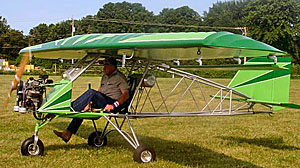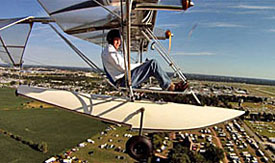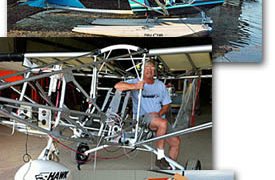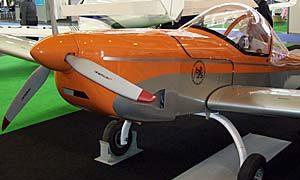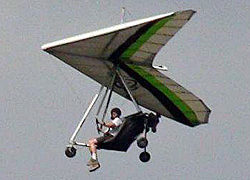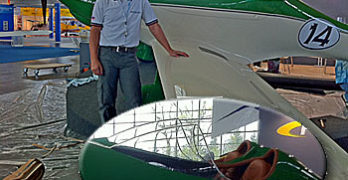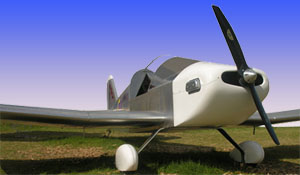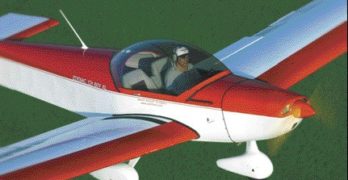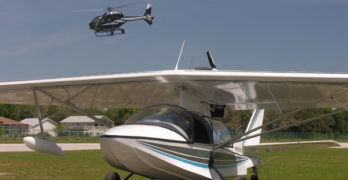One of my joys at AirVenture 2011 was visiting a seemingly revitalized Ultralight Area. Though a shadow of its former self in the 1980 heydays, new life seemed to be springing up, whether through electric powered aircraft or affordable Part 103 fixed wing designs.
Proving the naysayers wrong (again!) were at least two intriguing Part 103 airplanes you can buy and fly today for less than $20,000. That’s well the under the average price of a new automobile for a ready-to-fly aircraft with desirable features, not a stripped-down machine that no one really wants. I wrote about Terry Raber’s lovely little Aerolite 103. A day after looking over his work, UltralightNews and I shot a video review of the Valley Engineering Backyard Flyer. Once again, I had my eyes opened.
If you’ve ever visited AirVenture’s Ultralight Area, odds are you saw a pilot known as the “Flying Farmer” doing circuits of the Ultralight Area pattern.
Search Results for : four-stroke
Not finding exactly what you expected? Try our advanced search option.
Select a manufacturer to go straight to all our content about that manufacturer.
Select an aircraft model to go straight to all our content about that model.
AirVenture 2011 Wrap-Up and Summary
Oshkosh 2011 is history. By numerous accounts, this was a vast improvement over 2010 when the comments commonly went, “Well, I had some interest (in my airplane) and I hope to sell one or two… maybe.” This year I had easily 30 conversations revealing either outright positive successful results or varyingly robust mood indicators such as, “Looks like aviation has life in it again.” I heard from sellers and customers and rarely had to solicit their opinions. *** A number of aircraft purveyors said they took cash deposits and wrote firm contracts. I estimate about 30 aircraft sales by this method. Companies like Icon, Flight Design, and Terrafugia sold a large number of future delivery positions (more than 50, more than 60, and “several,” respectively). *** Icon neared or crossed the 500-on-order point, partly by “testing elasticity” in the pre-order market by lowering the A5 seaplane deposit to $2,000 from $5,000.
The Range of LSA is Wide as the USA
Plenty of folks think LSA are mainly carbon fiber speedsters with autopilots and huge computer screen instrumentation. No doubt, we have some beauties that are equipped like luxury sport planes. If you’ve got the budget, the Light-Sport industry has the aircraft. Yet not everyone can afford those birds and not everyone wants one. *** FAA pretty much eliminated ultralights when they came out with the SP/LSA rule… well, except for genuine ultralights of the single place variety. The latter still exist, and yes, you can still buy a ready-to-fly ultralight “vehicle” for which you need no N-number, no medical, and no pilot license. Those 254-pound (max empty weight) aircraft prove America remains the land of the free and I, for one, love to fly them. *** On our way north for AirVenture my wife, Randee, and I made a series of stops. In Alabama — just a mile apart — we hit two fixed wing producers of “ultralights” that qualify as official SLSA.
Aero 2011: New Single Place Aircraft
While some producers add four seaters (or more) to their LSA line, others have taken a different approach. The number of attractive new single-place models at Aero was surprising as most pilots seem to believe two seats are the minimum. *** However, for years AOPA surveys have shown the average occupancy of a GA aircraft — most of which have four seats and several models have more — is, wait for it… 1.6 persons. Given all those extra seats the 1.6 figure means a significant number of all flying is done solo. So, why pay for the extra seats when you fly solo frequently? Cost of acquisition and operation can be dramatically lower in a single seater, and you have no one else to please (or worry about) except yourself. *** I’m sure I didn’t see them all — Aero features a huge display of aircraft — but here’s a few of the new single seaters I discovered.
Which Kind of Pilot Are You?
I’ve observed aviation for more years than I’m comfortable admitting. As an aviation journalist I’ve often had a front row seat. I’ve talked to a ton of pilots (one of the great joys of my life is to have met so many fine folks). Over those years, I’ve distilled the kind of pilots we are to one or the other. Yes, just that simple: this kind or that. *** I believe you either fly to “Get Up,” or “Go Long.” Go Long flyers include all those who want to go some distance in their flying machine. Flying your own plane is a great way to travel. Speed is a big part of why flying is useful but that quality is merely one aspect of the enjoyment. *** Me? Sure, I like to Go Long. I’ve logged hundreds of hours of cross country flying, to all corners of America and some out of the USA.
Aero 2011 Pre-Show Attention Getters
The major European Airshow, Aero, opened this morning with the usual unveiling of new designs but one aircraft appeared to be the center of attention. Peter Funk had an idea five years back but shelved it for other projects. Now the time is right for his distinctly retro treatment of one of Light-Sport aviation’s sharpest designs, the Fk14 Polaris (Alert readers will identify Polaris as the Cirrus SRS, that GA company’s onetime entry in the LSA sweepstakes.) *** Even experts accustomed to following the latest in new or updated designs were caught off guard by the unorthodox entry (photo). With dual windscreens and race car bodywork, the open cockpit creation charmed many who gained early access to the great exhibit halls of Aero… 11 of them, each the size of a gymnasium. While exhibitors were assembling their displays Fk Lightplanes’ staff grabbed lots of attention with their Fk14 Lemans. *** Constrained by their ongoing contract with Cirrus until the end of the year, Fk Lightplanes sought permission before revealing Lemans and sales will not happen in 2011.
Single Place Onex — Inexpensive Aerial Fun
People tried to call it Oh-nex, but the giveaway is the single seat. I got it… One-ex. The clever name is adapted from the company name and one of its models, Sonex, and fits with the Waiex and Xenos. All are variations on a very successful theme (1,600 kits sold), and like the other models, Onex can be powered by the AeroVee engine. Along with a modestly priced airframe kit, the company’s own low-cost four-stroke engine helps to constrain the budget. *** A primary goal with Onex was to make ownership even more affordable, a challenge for a company that already boasts low prices. Onex is still in development so no performance numbers or costs have been finalized. But with a two-place Sonex at about $25,000 for all components including engine, Onex could be as low as $20,000, says the manufacturer. In 2010, that’s pretty amazing for an 80-hp single place that ought to perform like crazy and is suitable for most positive G aerobatics, says designer and general manager, Jeremy Monnett.
FPNA A-22 Capetown Amphibian
Capetown RacingLight-sport floatplane that’s a joy to fly
America has far more lakes than airports. By itself, my home state of Minnesota has more lakes than the entire nation has airports. Given this 50:1 advantage, floatplanes or seaplanes make a lot of sense; there are many places you can land, plus you can reach interesting locations you never considered in a land plane.
Lucky me. I’ve gotten to fly lots of light floatplanes and I get a huge smile on my face every time I launch from water or splash down in a lake. The sensation has no match in landplanes. Once you’ve flown a floatplane, you’ll forever look at flying through a new lens.
Imagine flying a mere wingspan above the water, safely|hopping over small islands and zooming down to the water’s surface on the far side, always landing directly into the wind, taxiing up to a dock or beaching on the sand or stopping to do a little fishing while standing on one float.
Budget Builds (Low Cost Homebuilts)
Yes! You can build and fly a “real” airplane for the cost of a new SUV.
Contrary to popular opinion,
airplanes don’t have to be outrageously
expensive-at least not
all of them. The Sport Pilot/Light-Sport
Aircraft initiative is one program that
promises to lower the cost of ready-to-fly
aircraft. But many of these Special LSAs
and Experimental LSAs will be priced
well more than $40,000 and can run
upwards of $85,000.
One way to get airborne for less
than $40K is to choose an ultralight,
powered parachute or weight-shift
trike. But if you want something more
conventional, more comfortable or
larger, you’re likely to find what you
want in the world of kit aircraft. After
all these years, building an Experimental/
Amateur-Built airplane still qualifies
as one of the least expensive ways
to get a get a great airplane into the air
on a reasonable budget.
Our $40K benchmark is designed
to narrow the field for builders on a
budget-and that benchmark means
a completed, ready-for-flight airplane.
SeaRey… American-Made Amphibian
SeaRey Sets a New Standard for Floatplanes
Many pilots who have flown in water-borne aircraft believe this is the
finest and most enjoyable flying one can do.
If that statement holds water (is true), then the beautiful SeaRey amphibian
from Florida-based Progressive Aerodyne should be one of the most desirable
aircraft you can buy.
Pilots have spoken with their money. Since it arrived on the market in 1992,
the SeaRey has sold in increasing numbers each year.
Three years of Progressive Aerodyne history hardly tells the story behind
the SeaRey. A father and son ownership team, Wayne and Kerry Richter have
long experience in this business producing many hundreds of amphibious
ultralights.
The Richters were principals in a company called Advanced Aviation best
known for its amphib sea plane called the Buccaneer. After another designer
made the first single place Buccaneer, Kerry Richter made his name with a
two place model.
- « Previous Page
- 1
- …
- 5
- 6
- 7
- 8
- 9
- …
- 13
- Next Page »


